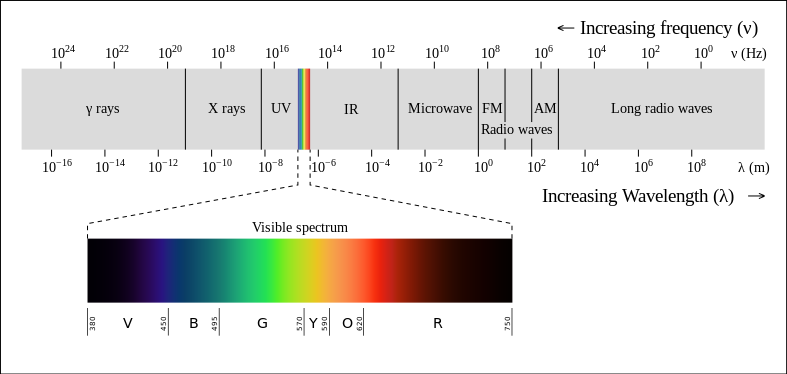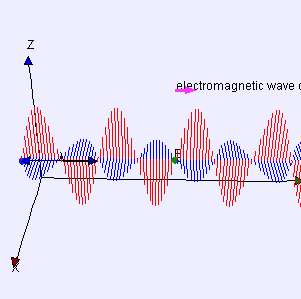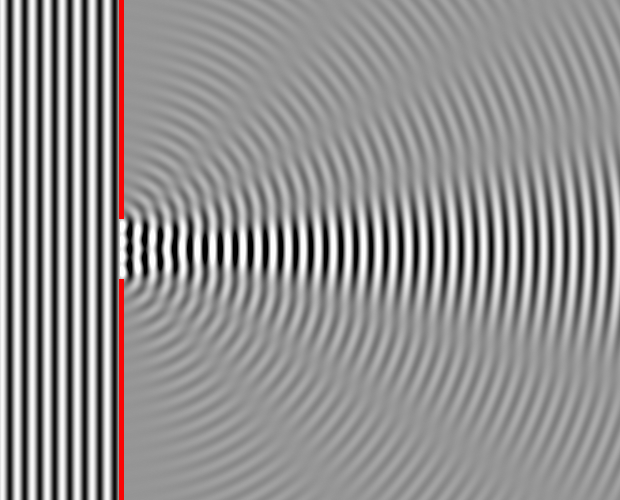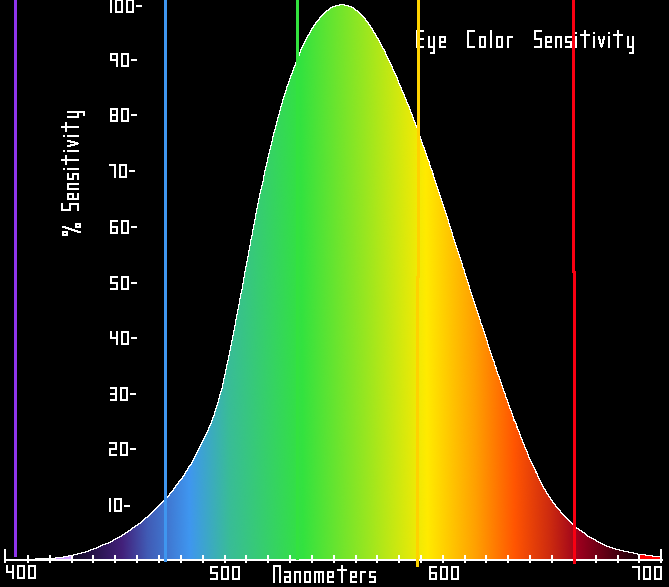Image Questions
Image Answers
-

Caption: The electromagnetic spectrum.
Note
wavelength = c / frequency where c is the vacuum light speed.Thus, wavelength and frequency contain the same information in a different form.Credit: Philip Ronan.
Image linked to Wikipedia.
Permission: Use under GNU Free Documentation License.

Caption: A cartoon animation of how a prism disperses white visible light into a continuous spectrum.
Actually the prism disperses some infrared and ultraviolet light, but the human eye doesn't notice that.
Credit: User:Kieff
Image linked to Wikipedia.
Permission: Public domain at least in USA.

Caption: This is a cartoon of electromagnetic radiation.
The diagram is meant to represent a one-line beam in space.
The oscillations of the electric field and the magnetic field have a directions in real space, but they extend in abstract electric field spaces and magnetic field spaces.
-
The lengths of the vectors are really the magnitudes of the
electric field
and magnetic field vectors.
EMR is a tranverse wave phenomena: the oscillation are perpendicular to the propagation direction: like waves on a string.
In EMR, the electric and magnetic fields are coupled.
You must have both for propagation of EMR.
The beam represents polarized light.
Real finite beams are made up of many subbeams with all orientations of the electric and magnetic field vectors.
The vectors don't cancel microscopically though.
Light can be polarized through various processes like those in polarized sunglasses.
Credit: User:Emmanuel.boutet
Image linked to Wikipedia.
Permission: Use under GNU Free Documentation License.

Caption: The animation shows a ray of polarized electromagnetic radiation propagating to the right.
Caption: This is a cartoon animation of electromagnetic radiation.
The animation is meant to represent a one-line beam in space.
The oscillations of the electric field and the magnetic field have a directions in real space, but they extend in abstract electric field spaces and magnetic field spaces.
-
The lengths of the vectors are really the magnitudes of the
electric field
and magnetic field vectors.
EMR is a tranverse wave phenomena: the oscillation are perpendicular to the propagation direction: like waves on a string.
In EMR, the electric and magnetic fields are coupled.
You must have both for propagation of EMR.
The beam represents polarized light.
Real finite beams are made up of many subbeams with all orientations of the electric and magnetic field vectors.
The vectors don't cancel microscopically though.
Light can be polarized through various processes like those in polarized sunglasses.
Credit: User:Lookang.
Image linked to Wikipedia.
Permission: Licensed under the Creative Commons Attribution ShareAlike 2.5.

Caption: "Approximate diffraction pattern of a single 4-wavelength-wide slit".
This is a 2-dimensional diffraction pattern.
The slit is about 4 wavelengths wide.
Waves come from the left and are diffracted through the slit.
Each point in the slit acts sort of like a point source of waves and the combination waves from each source gives rise to interference minima and maxima pattern which is the diffraction pattern.
You would see something like this in a water ripple tank experiment.
Credit: User:Dicklyon.
Image linked to Wikipedia.
Permission: Public domain at least in USA.

Caption: "A computer simulation of the intensity pattern (diffraction pattern) formed by a laser of 663 nm wavelength incident on a square aperture of 20 by 20 micrometer, visible on a screen placed 1 meter from the aperture." The image if real would measure 30 by 30 cm.
Note the small aperture. That's what gives rise to the big diffraction pattern.
If the aperture were progressively scaled up, the central maximum would expand into a big square beam of light that would be practically an image of the aperture. The fringes would would narrow down into near invisibility. With reflections and other sources of light, they would be washed away.
Credit: User:V81.
Image linked source to Wikipedia.
Permission: Public domain at least in USA.

Caption: "Results of a double-slit experiment performed by Dr. Tonomura showing the build-up of an interference pattern of single electrons. Numbers of electrons are 10 (a), 200 (b), 6000 (c), 40000 (d), 140000 (e)."
Electrons like photons are subject to the wave-particle duality of quantum mechanics---all microscopic particles are.
The diagram illustrates the double-slit experiment.
Each electron is in a continuum superposition of positions described by a wave function.
The wave function of each electron passes through both of two slits on a screen. Which means the electron passes through both of two slits on a screen.
The wave function interferes with itself and creates a probability interference pattern.
The probablity of absorption is determined by that pattern.
An electron creates one absorption at some point on an detection screen---we say there has been a wave function collapse.
The probability interference pattern creates the absorption interference pattern as the number of electrons passing through the two slits increases.
Eventually, a quasi-continuous pattern is built up and the individual electron behavior is washed out.
The double-slit experiment can be done with photons with the same results--light propagates like a wave and is absorbed like a particle.
The photon version actually doesn't prove photons exist----althought the point can be debated---but it is consistent with their existence. Given that photons exist, it does prove that each one goes through both slits and interferes with itself.
Remarkably, the photon version was done first in 1909 by Geoffrey I.~Taylor (1886--1975) (HZ-452--453).
Credit: Dr. Tonomura. Uploaded by User:Belsazar.
Image linked to Wikipedia.
Permission: Use under GNU Free Documentation License.

Caption: Human eye.
Credit: User:Che: Petr Novák, Wikipedia.
Image linked to Wikipedia.
Permission: Licensed under the Creative Commons Attribution ShareAlike 2.5.

Caption: "Eye sensitivity diagram (AKA luminosity function). The colored vertical lines are the wavelengths of some common laser colors. The yellow line is the 589nm sodium line."
This diagram is for photopic vision (i.e., human eye vision under well lit condtions). The other sensitivity curve is for scotopic vision (i.e., human eye vision under poorly lit condtions).
Credit: User:Skatebiker.
Image linked to Wikipedia.
Permission: Public domain at least in USA.
Videos
-
-
Diffraction videos:
- Interference-interferencia Interference in a ripple tank. Interference and diffraction are essentially the same thing. Interference is when the sources are few; diffraction is when the sources are many. The words are often used as synonyms. This looks a bit like an animation, but I think it's real.
- Ripple Tank Two Slit Interference Not bad. You see the contructive and destructive fringes.
- Diffraction of Light A tutorial, not a quick show. Too long for the classroom.
-
-
Light Diffraction videos:
- Young's Double Slit Experiment Well Jack Maxwell (the great, great, great grandson of Jim Maxwell) never uses slits, but it's still pretty nifty what you can do with laser pointer and some pencil leads. Actually, I think Jack M is relying on Babinet's principle: ``the diffraction pattern from an opaque body is identical to that from a hole of the same size and shape except for the overall forward beam intensity.''. He doesn't seem to know this. So his single slit acts as a double slit and his double slit acts as triple slit.
- Diffraction of Light A tutorial, not a quick show. Too long for the classroom.